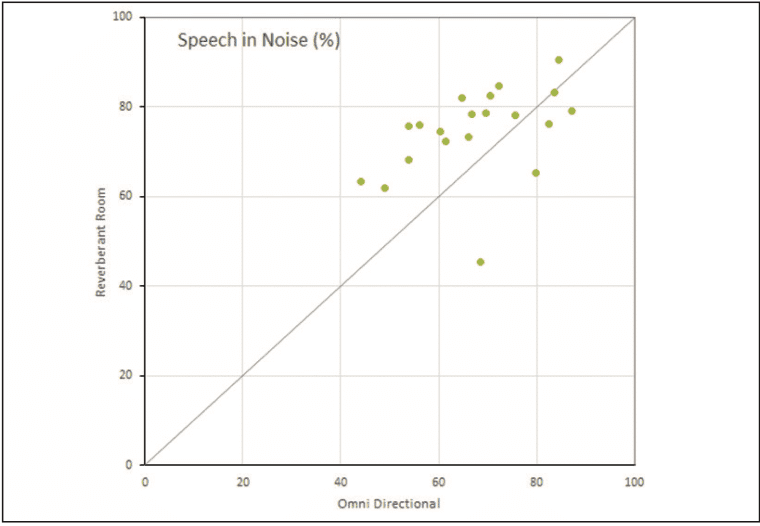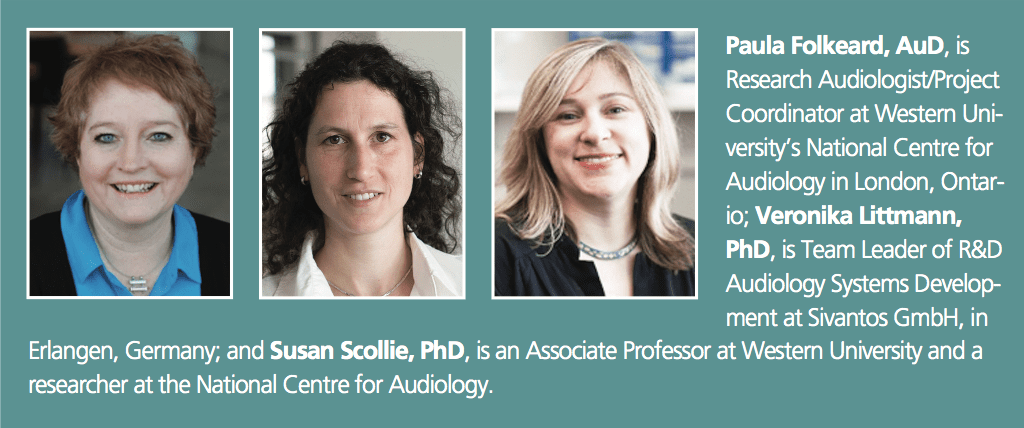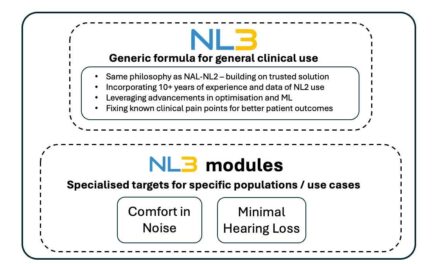Tech Topic | April 2017 Hearing Review
Study shows that adding a dereverberation program found in the Signia Primax RIC, improved speech intelligibility and reduced listening effort in the majority of the listeners tested using simulated reverberation.
Perceived listening effort refers to the subjective estimate of how taxing it is to listen in a particular environment or during a certain listening task.1 Both external factors (e.g. noise, reverberation, speaker accent) and internal factors (e.g. hearing loss, motivation, multi-tasking) that negatively affect the perception of speech can increase the amount of effort and cognitive resources required to understand what is being said.2-5 Studies comparing individuals with normal hearing and those with hearing loss have shown that people with hearing loss report more fatigue from listening (see Hornsby et al6 for a comprehensive review of fatigue research) and require more time than those with normal hearing to recover after being in environments requiring them to listen.7
Early studies showed that hearing aids can reduce listening effort by improving the audibility of speech,8 and advanced features such as digital noise reduction (DNR) and directional microphones (DM), can provide benefit in more complex and difficult listening environments.9-11 Picou et al12 noted the mounting evidence that children, older adults, and listeners with hearing loss are more sensitive to the effects of reverberation, suggesting the need for studies to examine the interaction between age, hearing loss, reverberation, and listening effort.
In this study, we investigated the effect of a hearing aid feature,“Reverberant Room,” on listening effort. The Reverberant Room feature combines several processors including DM, DNR, and “EchoShield.” EchoShield is a proprietary digital signal processing algorithm from Sivantos that operates on level differences between the direct sound and the reflected sounds to avoid over-amplifying the reflected sounds which are typically softer than those in the direct sound path.13,14 We measured both speech recognition and perceived listening effort for adult listeners with hearing loss.
Study Methods
Participants. Data from 20 participants (12 males, 8 females) were collected and analyzed. Participant ages ranged from 39-83 years with an average of 71 years. The average audiometric thresholds in each ear are plotted in Figure 1, along with the range of thresholds.

Figure 1. Average audiometric thresholds (left and right ears) for 20 listeners with hearing loss who participated in this study. Minimum and maximum thresholds are also shown as lower and upper boundaries (thinner lines).
Hearing aids. Participants were fitted binaurally with Signia Primax receiver-in-the-canal (RIC) hearing aids. All hearing aids were fitted with double domes to the receiver appropriate to the level of hearing loss (i.e. S, M, P). Two hearing aid programs were created using the Connexx 8 software: 1) Omni Directional and 2) Reverberant Room. Real-ear verification of the frequency response of the hearing aids was completed using an Audioscan VF2 (software v4.4) to ensure the aids were providing audibility across the frequency response.
Room set up. Participants were seated in the center of a double-walled sound booth surrounded by speakers at 0°, 45°, 90°, 135°, 180°, 225°, 270°, and 315°. The speakers were located at a distance of 110 cm (about 3.5′) from the subject center at a height of 120 cm (about 4′) from the floor to center speaker.

Figure 2. Participant and speaker configuration used during measurements of speech recognition and listening effort.
Speech-in-noise test. Participants were asked to listen to and repeat back Connected Speech Test (CST) sentences.15,16 Sentences were presented from the eight speakers with time and level differences across the speakers to simulate reverberation. The CST was modified such that 220 unique CST sentences were assembled using Adobe Audition to create four blocks of 55 sentences each. Background noise was created by mixing cafeteria noise and two passages of custom recorded male speech. This background noise was presented from all speakers except the forward-facing speaker (0°). For this study, the noise was presented at a fixed level 55 dB(A).
Procedure. Three blocks were chosen at random to present to the participant (one each for a practice run and for both test conditions: Omni Directional and Reverberant Room). The practice block was completed in the Omni Directional program. During the practice block, the level of the target sentences was varied to obtain a custom signal-to-noise ratio (SNR) for each participant where approximately 70% of the words were understood. The SNR was then fixed at that level for both test conditions. The order of the two test conditions was counterbalanced across participants, and the participants were not aware which program was being used during testing.
Rating scale. At the end of each block, participants were asked to rate the listening effort on a scale that ranged on a continuum from “No Effort” to “Extreme Effort” (cf, Holube et al5 and Luts et al17).
Results
Speech-in-noise scores. Data from the 20 participants were analyzed. Percentage correct scores were transformed to rationalized arcsine units (rau) prior to statistical analysis.18 A paired-samples t-test indicated a significant difference in scores for the Omni Directional condition (M=67.11, SD=12.54) and the Reverberant Room condition (M=74.14, SD 10.39); [t(19)=-2.616, p = .017].
On an individual basis, 75% of the participants improved their speech-in-noise score when using the Reverberant Room processor (Figure 3). This effect was highly consistent across individuals, with most showing the effect, and with the magnitude of the effect being approximately 10-20% for more than half of the participants. On average, the speech recognition scores in noise showed a 7% improvement with the Reverberant Room processor activated.

Figure 3. Speech-in-noise scores (% correct) using the Reverberant Room and Omni Directional settings of the Signia Primax hearing aid.
Subjective listening effort ratings. On an individual basis, three-quarters of the 20 participants rated the Reverberant Room program as requiring less listening effort than the Omni Directional program (Figure 4). A paired-samples t-test indicated that this difference was significant [t(19)=3.461, p = .003]. On average, the effort rating in the Omni Directional condition (M=5.4, SD=1.28) was about one category more difficult than the Reverberant Room condition (M=4.6, SD 1.3).
The participants who indicated the same or more listening effort in the Reverberant Room program were neither the youngest nor oldest in the group, had a wide range of hearing losses, and half had improved speech intelligibility scores on the Reverberant Room program compared to the Omni Directional program.
Conclusion. Adding a dereverberation program as an option for a hearing aid user improved speech intelligibility and reduced listening effort in the majority of the listeners we tested in the lab using simulated reverberation.

Figure 4. Listening Effort Ratings provided by participants using the Reverberant Room and Omni Directional settings of the Signia Primax hearing aid.
One limitation of this study is that we cannot say which of the Reverberant Room processor’s sub-features (anti-reverberation, directionality, or noise reduction) was primarily responsible for the improvements that were observed. It may be that they contributed individually or synergistically, and this was not assessed in this project.
However, these results are encouraging in several ways. First, the improvement was measured despite the use of a very challenging listening situation, with simulated reverberation and a background of noise that included cafeteria noise and speech mixed together. Second, the improvements were noted for most of the participants in this study. Third, the improvement was noticeable to the participants even under blinded measurement conditions in which they were not aware of which processor offered the Reverberant Room processor. Taken together, these results may indicate that real-world benefit is possible with this processor. Further testing would be needed in reverberant spaces to evaluate this directly.
References
-
Lemke U, Besser J. Cognitive load and listening effort: concepts and age-related considerations. Ear Hear. 2016;37(1):77S-84S.
-
Mattys SL, Davis MH, Bradlow AR, Scott SK. Speech recognition in adverse conditions: A review. J Lang Cogn Proc. 2002. Available at: http://www.mrc-cbu.cam.ac.uk/personal/matt.davis/pubs/mattys_lcp2012.pdf
-
Van Engen KJ, Peelle JE. Listening effort and accented speech. Frontiers Human Neurosci. 2014;8:577. Available at: http://doi.org/10.3389/fnhum.2014.00577
-
Rudner M. Cognitive spare capacity as an index of listening effort. Ear Hear. 2016;37(1):69S-76S.
-
Holube I, Haeder K, Imery C, Weber R. Subjective listening effort and electrodermal activity in listening situations with reverberation and noise. Trends in Hearing. 2016; Available at: https://www.ncbi.nlm.nih.gov/pmc/articles/PMC5051672
-
Hornsby BWY, Naylor G, Bess FH. A taxonomy of fatigue concepts and their relation to hearing loss. Ear Hear. 2016;37(1):136S-144S.
-
Nachtegaal J, Kuik DJ, Anema JR, Goverts ST, Festen JM, Kramer SE. Hearing status, need for recovery after work, and psychosocial work characteristics: Results from an internet-based national survey on hearing. Int J Audiol. 2009;48(10):684-691.
-
Humes LE, Christensen L, Thomas T, Bess FH, Bentler R. A comparison of the aided performance and benefit provided by a linear and a two-channel wide dynamic range compression hearing aid. J Speech Lang Hear Res. 1999;42(1):65-79.
-
Ricketts T, Hornsby BWY. Sound quality measures for speech in noise through a commercial hearing aid implementing digital noise reduction. J Am Acad Audiol. 2005;16(5):270-277.
-
Desjardins JL, Doherty KA. The effect of hearing aid noise reduction on listening effort in hearing-impaired adults. Ear Hear. 2014;36(6):600-610.
-
Desjardins JL. The effects of hearing aid directional microphone and noise reduction processing on listening effort in older adults with hearing loss. J Am Acad Audiol. 2016;27:29-41.
-
Picou EM, Gordon J, Ricketts TA. The effects of noise and reverberation on listening effort in adults with normal hearing. Ear Hear. 2016;37(1):1-13.
-
Herbig R, Froehlich M. Reducing listening effort via primax hearing technology. June 9, 2016 (Article 17275). Available at: http://www.audiologyonline.com/articles/reducing-listening-effort-via-primax-17275
-
Littmann V, Froehlich M, Beilin J, Branda E, Schaefer PJ. Clinical Studies Show Advanced Hearing Aid Technology Reduces Listening Effort. Hearing Review. 2016;23(4):36.
-
Cox RM, Alexander GC, Gilmore C. Development of the connected speech test (CST). Ear Hear. 1987;85(5):119S-126S.
-
Cox RM, Alexander GC, Gilmore C. Use of the connected speech test (CST) with hearing-impaired listeners. Ear Hear. 1988;9:198-207.
-
Luts H, Eneman K, Wouters J, Schulte M, Vormann M, Buechler M, Houben R, Froehlich M, Grimm G, Leijon A, Lombard A, Mauler D, Spriet A. Multicenter evaluation of signal enhancement algorithms for hearing aids. J Acoust Soc Am. 2010;127(3):1491-1505.
-
Studebaker GA. A “rationalized” arcsine transform. J Speech Hear Res. 1985;28(3):455-462.
CORRESPONDENCE can be addressed to HR or Dr Folkeard at: [email protected]
Citation for this article: Folkeard, P, Littmann V, Scollie S. Using a De-reverberation Program to Improve Speech Intelligibility and Reduce Perceived Listening Effort. Hearing Review. 2017;24(4):32-33.





